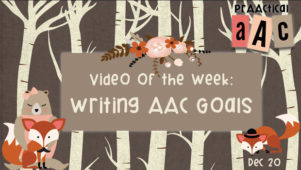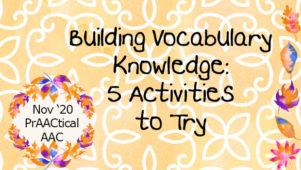Beyond Requesting: Thoughts on Teaching Information Transfer

Although it has been close to 25 years since Dr. Janice Light’s hallmark paper on communicative competence in AAC discussed four main purposes of communication, many AAC systems are still heavily populated with messages for basic wants and needs. The other areas – information transfer, social closeness, social etiquette – are often underrepresented in AAC systems. We scratched the surface of how to teach basic requesting last month, and now we’re ready to talk about communicating for other reasons. In this post, we’ll talk about some of the clinical issues in teaching communication for the purpose of information transfer.
A big reason that we express ourselves is to share information that others want or need. It may not seem like a high priority until we realize how often we need to do this to function in our daily lives. Here are some examples, both positive and negative, from our work with children and adults who use AAC.
- Jonathan knew the answer to a question posed in his Language Arts class. He was able to signal the teacher and respond using his SGD.
- At Morning Circle, Bella had something to share about what her family did over the weekend. It was recorded in a single message SGD (aka talking switch) that traveled back and forth from school to home. She used that to tell her teacher and classmates about the new Wii game they got.
- Mrs. Aronson was having house guests for the holidays and needed to cancel her next appointment. She used her communication wallet, gestures, and natural speech to convey this to her SLP.
- Jamie needed her aide to know that Mom would be picking her up early for a medical procedure. There was a note in her backpack with the specifics, but Jamie had no way to let the aide know about it. As a result, she wasn’t ready when Mom arrived causing them to miss their appointment time.
- Ethan was anxious for a few hours after the fire drill. He needed a way to tell his afterschool care providers that he was upset so that they could guide him through some self-calming strategies. Because he was unable to share this information, they were unable to support him appropriately. As a result, there was a major aggressive episode.
- Mr. Allan was leaving on a trip and needed to have a neighbor feed his cat. He tried to communicate this via natural speech and gestures, but did not feel confident that his neighbor understood. A set of messages was added to his communication book so that he could convey that information.
- Kara completed the assigned reading for her social studies class, but was unable to complete the homework because no one had scanned in the document to make it accessible. Kara was unable to convey this effectively to her teacher and got a zero for that assignment. This problem occurred several times before Kara was able to get her point across.
Being able to provide information in situations such as these is not a trivial matter and it takes some careful intervention to help our AAC clients develop skills in this area.
Information transfer has two parts: providing information and requesting it. Here are some thoughts on teaching people who use AAC to tell, explain, and describe.
- Write goals to address this skill area. Some examples:
- Given minimal prompting, __ will use a single message SGD or AAC app to relay information between home and school settings.
- When provided with prestored messages on her SGD, __ will relay news, announcements, and directions to a group of peers.
- __ will initiate comments about new events, changes in routines, or other novel occurrences at least twice/session.
- When a problem occurs, __ will report it to a caregiver within 12 hours.
- __ will give accurate responses to open-ended questions about reading, math, or science content using core word
 vocabulary at least once per class period.
vocabulary at least once per class period. - Given a sequenced task with which __ needs help, he will give directions for the final two steps in the process.
- When telling personal narratives, __ will consider the partner’s perspective and include all relevant information.
- Following each session, __ will give scheduling and/or billing information to familiar partners.
- Metalinguistics can help. Consider making it a practice to use the ‘language of talking’ when working with your AAC learners. Over time, this can help them get comfortable thinking and talking about talking. “Today, we’re going to do some practice with action words/verbs. Let’s think about where we would go in your talker to find them.”
- Model information sharing using aided language input.

- Use a think-aloud strategy. Make your inner thought processes overt by narrating them. This gives the AAC learner some insight into how you approach a task, such as using modals or verb phrases in a sentence. “So, I want to tell her that maybe I will go but maybe I won’t. I can use ‘may’ for that. ‘May.’ Let’s see…that’s a helping verb. So I can go to the verb folder and…”
- Provide explicit instruction. Plan activities to directly teach these skills. Sounds obvious, I know. But sometimes we’re surprised when SLPs jump right into asking the client to demonstrate skills, rather than teaching them first. How might we teach these skills?
- Explain what to do with client-friendly language.
- Create a visual support showing the process. Use that when explaining what to do, during the activity, and/or when recapping what happened.
- Set up the materials and demonstrate
- Create an opportunity for using the skill and practice.
- Give instructive and supportive feedback.
- End on a correct production, even if you have to provide considerable support.
- Provide a sufficient number of focused communication opportunities for practice. If we’ve done our job right, the goals we wrote focus on an authentic need that the AAC learner has. The problem at this stage is that the need for this skill may not occur very frequently. If we relied only on that authentic situation for practice, the AAC learner isn’t getting enough
 experience to build his/her skills. People with learning challenges need lots of practice; The more severe the challenge is, the more practice they need. Spacing out that practice too widely can slow down the learning process even further. When we’re teaching the new skill, we have to find, develop, or invent many more practice opportunities and insert those into the day. Just relying on the need to occur spontaneously won’t do the trick for most AAC learners developing skills in this area.
experience to build his/her skills. People with learning challenges need lots of practice; The more severe the challenge is, the more practice they need. Spacing out that practice too widely can slow down the learning process even further. When we’re teaching the new skill, we have to find, develop, or invent many more practice opportunities and insert those into the day. Just relying on the need to occur spontaneously won’t do the trick for most AAC learners developing skills in this area. - Question your assumptions. Many of the strategies we suggested, like using metalinguistics or think-aloud, require good deal of language comprehension. Many times, our AAC clients haven’t conclusively demonstrated their ability to understand full sentences or abstract vocabulary. Does that mean that we should avoid using these strategies? Not necessarily. Chances are, they can understand more than they’ve demonstrated. Of course, it’s not always appropriate to use verbally-loaded strategies. Some learners need smaller doses of language input. As with any AAC intervention, we’d make these decisions on an individual basis.
Do you work on information transfer with clients on your AAC caseload? We’d love to hear your experiences and ideas.
Light, J. (1989). Toward a definition of communicative competence for individuals using augmentative and alternative communication systems. Augmentative and Alternative Communication, 5,2,137–144.
Filed under: Strategy of the Month
Tagged With: AAC goals, communicative competence, information transfer, language intervention, strategy
This post was written by Carole Zangari





2 Comments
Carole, I just wanted to say thanks for such a great site. I’ve been reading for a few months now and have learned so much that is so pertinent to raising my boy with complex communication needs.
Shelane, thank you so much for your message. We are so glad that the thoughts and strategies have been helpful. SO nice of you to take the time to stop by and share this comment. 🙂